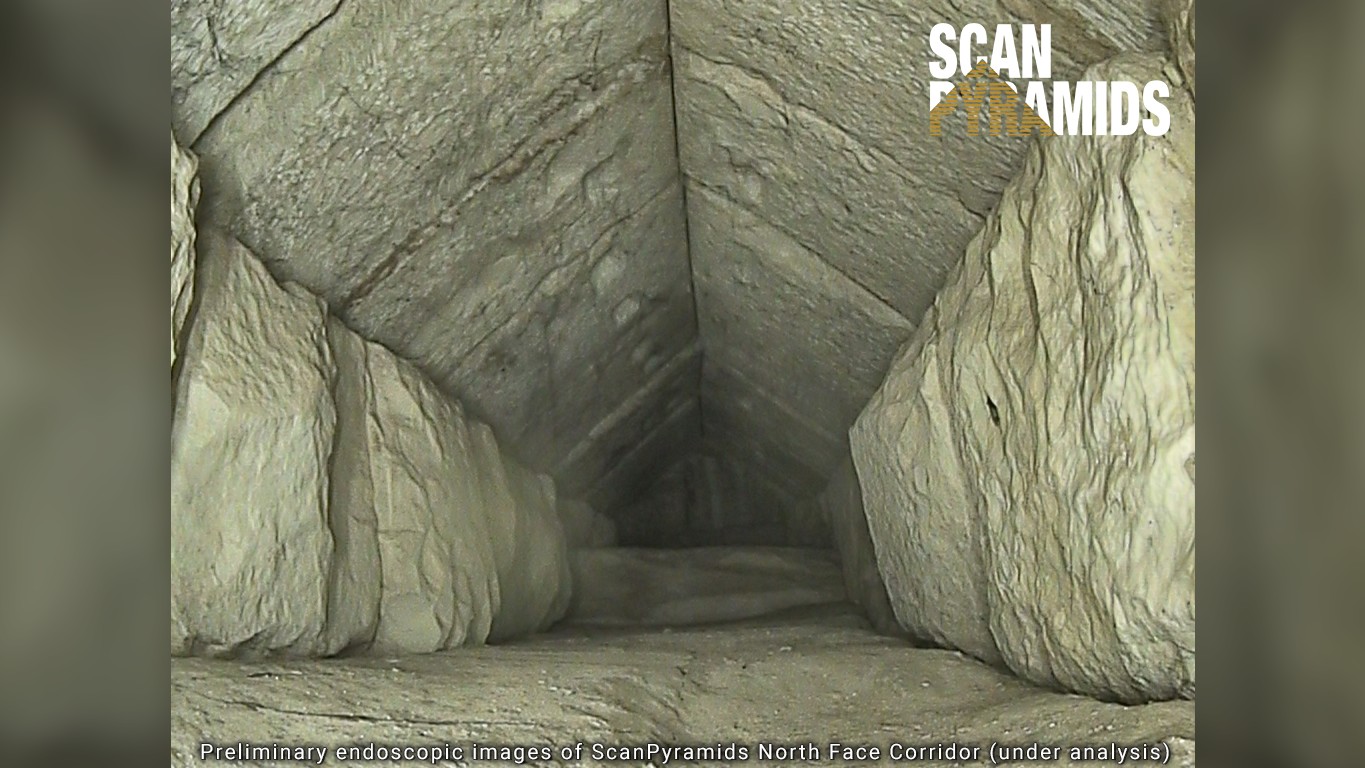Cosmic rays reveal 'hidden' 30-foot-long corridor in Egypt's Great Pyramid
For years, scientists have known there was something hidden above the entrance to the Great Pyramid. Now, they've finally revealed it.

Cosmic rays and photos from an endoscope have revealed a "hidden" corridor inside the Great Pyramid of Giza's north face, above the pyramid's ancient entrance, new research finds.
The Great Pyramid was built on orders of the pharaoh Khufu (ruled circa 2551 B.C. to 2528 B.C.) on the Giza plateau and today is about 456 feet (139 meters) high. It is the only surviving wonder of the ancient world and was the tallest building on Earth until 1311, when England's Lincoln Cathedral's 525-foot-tall (160 m) central tower was completed.
A new study reveals that, just above the ancient entrance to the pyramid, there is likely a horizontal chamber that runs for 30 feet (9 m) in length and is 6.6 feet by 6.6 feet (2 by 2 m) in width and height. It is located behind a chevron-shaped structure that is visible outside the pyramid, according to the study, published Thursday (March 2) in the journal Nature Communications.
To learn more about the void, the scientists inserted an endoscope into the corridor to peer inside on Feb. 24 , they announced in a statement. But so far, the team has not found any artifacts inside the corridor, they told Live Science.
"The first pictures taken with the endoscope seem to show there is nothing, but we cannot see all the room precisely yet," study first author Sébastien Procureur, a physicist with the French Alternative Energies and Atomic Energy Commission (CEA), told Live Science in an email.
Related: What did the ancient Egyptian pyramids look like when they were built?
Procureur also refuted media reports that the team was close to a hidden burial chamber of Khufu, saying that the team hasn't found any evidence of a secret tomb.
Get the world’s most fascinating discoveries delivered straight to your inbox.
Scientists discovered this corridor while analyzing so-called muon scans of the 4,500-year-old Great Pyramid. Muons are negatively charged elementary particles that form when cosmic rays collide with atoms in Earth's atmosphere. These high-energy particles constantly rain down on Earth but interact differently with stone than with air. For the past decade, scientists have been using muon detectors to search for hidden chambers in the Great Pyramid.
"To our knowledge, this study is the first characterization of the position and dimensions of a void detected by cosmic-ray muons with a sensitivity of a few centimeters only," the researchers wrote in the study.
In their statement, the scientists added that ground-penetrating radar was also used to gather information on the corridor.
For several years, scientists have known that there was something hidden behind the north face of the pyramid. They announced the discovery of a "void" behind the north face of the Great Pyramid in 2016, but it wasn't until now that they were able to reveal this 30-foot-long corridor.
In 2017, scientists announced the discovery of a larger void, about 98 feet (30 m) long, located above the pyramid's "grand gallery," but a more precise analysis of this void has not yet been completed.
Zahi Hawass, Egypt's former antiquities minister, said during a news conference Thursday (March 2) that the 30-foot-long corridor was likely created to help relieve stress from the weight of the building material on the Great Pyramid. He noted that it is located behind a chevron-shaped structure that distributes weight, the Egyptian newspaper Ahram Online reported.
Procureur agreed that the corridor may be related to the construction of the chevron. "If I had to make a guess, I'd say it could have been a first test of the chevron structure" that was later used higher up in the pyramid, Procureur said.
Reg Clark, an Egyptologist at Swansea University in the United Kingdom who is not affiliated with the study, told Live Science in an email that "I am of the opinion that the small gabled roofed corridor was probably intended to act as a relieving chamber over the pyramid's original descending entrance passage." It's unlikely that the discovery of the corridor will lead to a major find inside, he noted.
"I doubt whether the passage will lead to anything of any other significance. As with many of these structural innovations in the pyramids, which were developed for pragmatic reasons by the Egyptian tomb builders," Clark said. "They are often the victim of 'wishful thinking' by those looking for 'pyramid mysteries' and thus, sadly, frequently the subject of wild speculation in the press and media."
There is a plan to use more sensitive muon detectors that may be able to detect artifacts in this corridor and in the larger void above the grand gallery. A multinational scientific team has gotten approval from the Egyptian Ministry of Tourism and Antiquities and is currently trying to secure funding.

Owen Jarus is a regular contributor to Live Science who writes about archaeology and humans' past. He has also written for The Independent (UK), The Canadian Press (CP) and The Associated Press (AP), among others. Owen has a bachelor of arts degree from the University of Toronto and a journalism degree from Ryerson University.


![Using dedicated laser surveys and photogrammetry data, researchers were able to create a 3D modelization of the Great Pyramid. This is an East-West cut view of the Great Pyramid and also the front view of the North face Chevron Area. Labels are as follows: a) Subterranean chamber, b) queen’s chamber, c) grand gallery, d) king’s chamber, e) descending corridor, f) ascending corridor, g) al-Ma’mun corri[1]dor, h) north face Chevron area, i) ScanPyramids Big Void with horizontal hypothesis (red hatching) and inclined hypothesis (green hatching).](https://cdn.mos.cms.futurecdn.net/RQ8dmZ8yQvhqedfK39uBv7.jpg)
